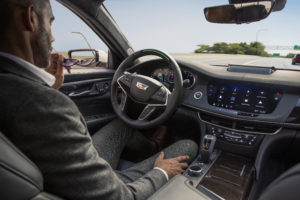
Drivers prefer ADAS over self-driving vehicles, report shows
By onMarket Trends | Technology
A newly-released report has found that while those shopping for a new car want the vehicle to include advanced driver assistance systems (ADAS), they are less enthusiastic about semi-autonomous features.
Trust and familiarity remain barriers preventing drivers from embracing self-driving technologies, S&P Global Mobility’s newly released Global Mobility spring survey found.
“There is a lack of exposure to the mainstream consumer,” said Yanina Mills, senior technical research analyst at S&P Global Mobility. “They don’t exactly know how it is going to work. There is confusion. They are asking, ‘Is it self-driving, or is it just going to help me a bit and I still have to focus?’”
The survey noted that, unlike self-driving features, drivers are already familiar with ADAS features, with about 35% of those surveyed already owning vehicles with forward collision warning and 30% driving vehicles with blind spot detection.
Among the most sought-after ADAS features drivers are seeking in their next vehicles are blind spot warning, automatic emergency braking for cyclists and pedestrians, and night vision.
“Exposure is helping to drive much of the desirability for these features,” Mills said.
Conversely, most of the shoppers surveyed had virtually no experience with self-driving, “inhabiting its desirability,” the report noted, adding that automated driving is the least desirable ADAS feature listed in its survey.

Most OEMs now offer Level 2 systems that assume at least a portion of some driver tasks while requiring the person behind the wheel to pay attention.
With the survey indicating that drivers prefer technologies that allow them to remain in control, S&P analysts said they’re only now beginning to see hands-off systems moving outside of premium models.
“Consumers aren’t able to find a use case that [autonomous driving features are] relatable to them,” Mills said.
Not everyone is against autonomous cars, however, with the survey finding that among polled customers:
-
- 53% of consumers felt the autonomous car would drive more efficiently than a normal car;
- 48% felt that it would be safer; and
- 27% would use it to relieve tedious driving conditions.
Mills said that if OEMs want to convince more buyers to transition to autonomous driving systems, they must do a better job of more effectively marketing their benefits.
The survey also found that appetite for autonomous driving varies based on geographical region, with those in Mainland China more interested in self-driving technology. Conversely, U.S., U.K., and German consumers showed the lowest scores in demonstrating interest.
Brock Walquist, senior technical research analyst at S&P Global Mobility, said it’s a matter of trust.
“The whole idea of a system that takes control from the driver continues to not sit well with consumers,” he said.
According to the report, just 47% of consumers said they would ride in a car with self-driving abilities and that they would consider purchasing one.
“Optimism about self-driving cars remains cautious at best – and consideration is high up the purchase funnel before the papers get signed,” it said.
The report also found that when it comes to safety:
-
- About 81% of buyers are willing to pay more for vehicles with higher safety ratings;
- 92% state that safety ratings are “somewhat” or “very important” when buying a vehicle; and
- More than 50% of buyers expect these features to be standard.
“Consumers have an expectation that safety equipment should just be a part of every vehicle produced and sold,” said Jeremy Carlson, lead analyst for autonomy at S&P Global Mobility.
“They’ll ask themselves, ‘If it’s a critical safety technology, why are you asking me to pay for it on top of my vehicle purchase?'”
Walquist added that it doesn’t help to consider that vehicle safety ratings have a “weak-to-nonexistent” link to ADAS.
“Most rating organizations might recommend AEB,” he said. “They might recommend lane-keep assist. But they are not part of the scoring protocols.”
Earlier this month, Mercedes‑Benz received approval in California for its Level 3 automated driving feature, Drive Pilot, making the OEM the first in the U.S. to offer an SAE Level 3 feature on standard production vehicles.
Tesla vehicles are widely popular in California but the OEM’s highest autonomous driving feature reaches SAE Level 2 functionality, which still considers the driver to constantly supervise control of the vehicle. General Motors’ Super Cruise features are also Level 2.
Drive Pilot will be available as an option beginning with model year 2024 S-Class and EQS Sedan models in California and Nevada, with the first cars delivered to customers late this year. Nevada confirmed the compliance of the feature with state regulations in January. Mercedes plans to branch out to other markets in the future.
Image
A 2019 Cadillac CT6 runs Super Cruise. (Provided by Cadillac)
